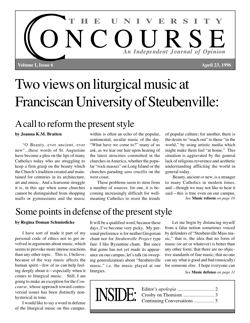Liturgical music at FUS: A call to reform the present style
by Joanna K. M. Bratten
“O Beauty, ever ancient, ever new”...these words of St. Augustine have become a plea on the lips of many Catholics today who are struggling to keep a firm grasp on the beauty which the Church’s tradition created and maintained for centuries in its architecture, art and music. And a fearsome struggle it is, in this age when some churches cannot be distinguished from shopping malls or gymnasiums and the music within is often an echo of the popular, sentimental, secular music of the day. “What have we come to?” many of us ask, as we tear our hair upon hearing of the latest atrocities committed in the churches in America, whether the popular “rock masses” on Long Island or the churches parading sans crucifix on the west coast.
These problems seem to stem from a number of sources: for one, it is becoming increasingly difficult for well-meaning Catholics to resist the trends of popular culture; for another, there is the desire to “reach out” to those “in the world,” by using artistic media which might make them feel “at home.” This situation is aggravated by the general lack of religious reverence and aesthetic understanding afflicting the world in general today.
Beauty, ancient or new, is a stranger to many Catholics in modern times, and—though we may not like to hear it said—this is true even on our campus, as is often evident in our liturgical music.
In a helpful move toward improving the situation, a wonderful conference on Sacred Music was held on campus several weeks ago, wherein some noted speakers (including Thomas Day, author of Why Catholics Can’t Sing, Mgs.
Richard Schuler and Mark Bradford) spoke on issues surrounding Sacred Music, as it is discussed in Vatican II—its roots in chant, the importance of a solid music education in seminaries, the decay of sacred music in America.
The one unfortunate aspect of the conference was the small number of students in attendance. There were scarcely more than a handful at the lectures—which seems odd, considering our University’s (rare) concern for liturgical correctness. It was a relief, however, to see the splendid response to the Latin Ordo Missae on Sunday morning. This special Mass, which closed the conference and packed the chapel, seemed an example of what FUS is truly capable of in the area of liturgy. It featured beautiful music by the University Chorale, the Schola, the chapel choir and the faculty/staff choir. One must wonder why Masses such as this do not become the norm here.
The liturgical music at Franciscan University has, over the years, come much closer to what we witnessed at the conference Mass. Chapel Ministry has brought more traditional elements of the Mass back into our liturgies: the traditional Latin responses, organ music, and occasional Latin Masses. But it can go much further in the right direction. The University is equipped with musicians who are able to provide traditional choral music, chant, organ music—all the beautiful liturgical music of the past centuries and of today. Why, then, do we not embrace what is plainly most beautiful for our Masses; settling instead for what some might call second-best?
I do not mean to condemn those who prefer the music found in The University Songbook in our chapel to Gregorian chant, nor to question the sincerity of their worship. I wish, however, to ask why they prefer such songs as “We Welcome You,” “Soften My Heart With Oil” or “The Sweetness of the Lord” during the Liturgy, when they might have Gregorian chant, choral works and sacred music by (to name a few) Bach, Schubert, Gorecki, or Paert, or traditional hymns such as “Beautiful Savior” or “Crown Him With Many Crowns”?
I realize that I open myself up to be questioned in return: Why must the latter necessarily take precedence over the former? I submit three reasons in reply: lyrical content, aesthetic quality and objective fittingness. The lyrics of many of the songs we sing during our campus liturgies are either poorly-written or more self-focused than God-focused. These defects tend to detract from the solemnity and sacredness of the liturgy—particularly the frequent focus upon self. Look closely, for example, at lyrics from “We Welcome You”: “We are all together to glorify Your name; there’s nothing we like better than to sing and give You praise.” Clearly the attempt is to express the joy of praising God as a people, but the predominant sentiment is inappropriately self-preoccupied.
Authentic worship requires an attitude of profound self-forgetfulness in the face of the holy.
While it is true that one aspect of worship is our presence together as a community, it is dangerous and somewhat presumptuous ever to make this aspect the focus of our attention. Further, I imagine the deeply devout would not care to glibly inform God that “there’s nothing I like better than to sing and give you praise,” partly because, being human, it is not always true. There should be more spiritual honesty and humility—indeed, contrition—in the lyrics of the songs we select for our liturgies.
The aesthetic qualities lacking in many of our favorite songs pose a second reason to call such music second-best. Few of the songs in The University Songbook express a sense of the sublime or of truly transcendent beauty, majesty or power. What is most often expressed is a sense of very sincere sentimentality, which can also be found in the sugar-coated melodies of many poorly-written love songs of the 60s and 70s.
Third is the question of objective fittingness, which ties the previous two points together. Not every beautiful or pleasing piece of music is fitting for a communal worship service, much less the holy sacrifice of the Mass. Even supposing a certain musical work does—in lyrical and aesthetic quality—aspire to higher levels, it would not necessarily follow that it is a good choice for the Mass. Beethoven’s Ninth Symphony, for example, is perfection in a concert hall but would be quite out of place in a liturgical setting. How much more unfitting, then, are songs that hardly attempt to rise above the mundane?
It is true that many more recent hymns speak to people, especially young people, in a very positive and personally influential way. This fact I can neither discard nor condemn. Because these songs do help draw many people closer to Christ, we cannot arrogantly throw them aside, labeling them tacky and useless. Such songs have their place at youth conferences, retreats, prayer meetings and informal spiritual gatherings. But all of these events differ greatly from the sacred liturgy, wherein we partake intimately in the most solemn Mysteries of our Faith.
University students are beginning to take a wide interest in the subject of beauty in art—from liturgical music to architecture. There is increasing consensus about the failure of today’s church architecture to express adequately what the Church is about: namely leading souls to God. The subject of music, too, is on the minds of a growing number of FUS students and faculty, and the beautiful demonstration at the conference Mass was enough to convince me, as well as many others, that we as a community can do a much better job than we are presently doing in adoring our Creator in song.
This is not a question of “charismatic” vs. “traditional” music. It is a question of having a standard, of choosing that musical medium which best serves the Church and her members in seeking and finding God.
All can readily acknowledge that the presence of God is purely and strongly recognized in beautiful art—works which transcend the dust of this earth and speak to us of something purer and higher, something pristine. In a world increasingly dry and bereft of beauty, the Church is meant to be something of an oasis. We must be careful not to invite the duststorm of modernity into the serene oasis we call Mother Church. Let us then, as an intellectual and faith community striving for holiness and communion with Christ, reconsider how we choose to enrich our spiritual development, and honestly ask ourselves whether we have chosen well.
Joanna Bratten is a Junior, English Drama major and a member of the Concourse staff of assistants.


